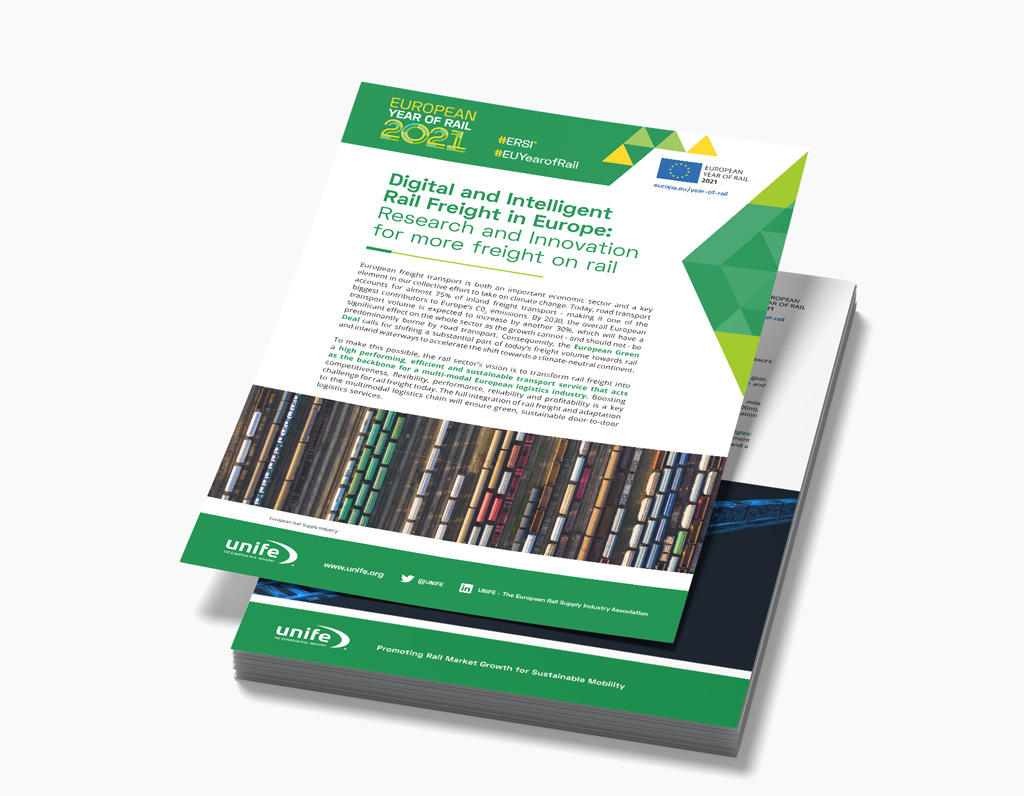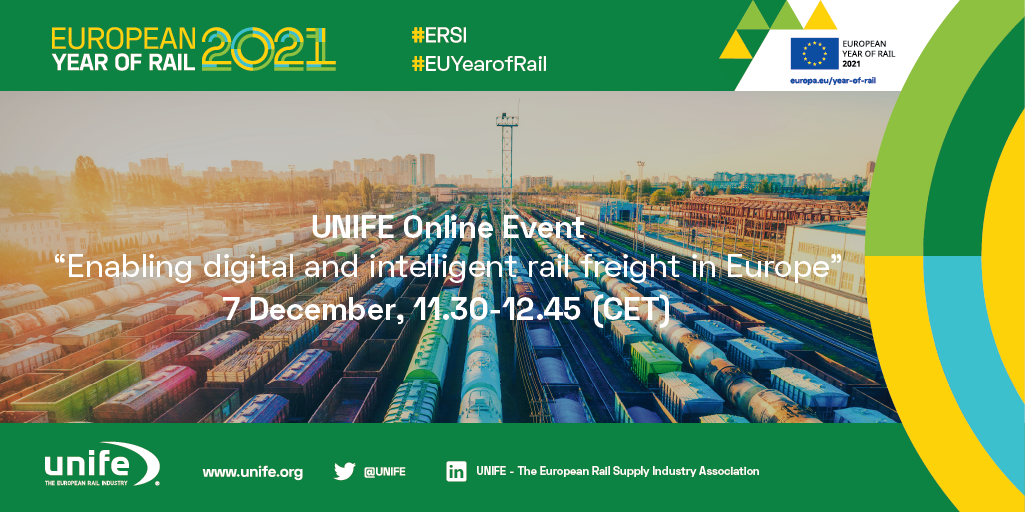Interactive Factsheet
Digital and Intelligent
Rail Freight in Europe:
Research and Innovation for more freight on rail
European freight transport is both an important economic sector and a key element in our collective effort to take on climate change. Today, road transport accounts for almost 75% of inland freight transport – making it one of the biggest contributors to Europe’s C02 emissions. By 2030, the overall European transport volume is expected to increase by another 30%, which will have a significant effect on the whole sector as the growth cannot – and should not – be predominantly borne by road transport. Consequently, the European Green Deal calls for shifting a substantial part of today’s freight volume towards rail and inland waterways to accelerate the shift towards a climate-neutral continent.
To make this possible, the rail sector’s vision is to transform rail freight into a high performing, efficient and sustainable transport service that acts as the backbone for a multi-modal European logistics industry. Boosting competitiveness, flexibility, performance, reliability and profitability is a key challenge for rail freight today. The full integration of rail freight and adaptation to the multimodal logistics chain will ensure green, sustainable door-to-door logistics services.
Status: Inputs from Shift2Rail
Starting in 2014, the Shift2Rail Joint Undertaking (S2R JU), the EU’s Public-Private Partnership for Research and Innovation in rail, has laid the foundation to start the transformation process to a digitized and automated rail freight system.
The Innovation Programme 5 (IP5), dedicated to “Technologies for Sustainable & Attractive European Rail Freight”, has covered five areas of development:
- Fleet Digitalisation and Automation: Condition-based maintenance (CBM), Digital Automatic Coupling (DAC), Automated freight train / ATO and DAS
- Digital Transport Management: Improved methods for timetable planning, real-time yard management & single wagon load system, real-time network management and intelligent video gate
- Smart Freight Wagon Concepts: Running gear, core market wagon, extended market wagon and telematics and electrification
- New Freight Propulsion Concepts: last mile propulsion systems, long trains (up to 1500m), freight locomotive of the future and hybridisation of legacy shunters
- Business analytics & implementation strategies: Identification of market segments, development of specifications, key performance indicators and a migration plan.
The European DAC delivery program
In 2021, the launch of the Shift2Rail European DAC Delivery Programme (EDDP) generated a special focus on preparing for the transition to Digital Automatic Coupler (DAC).
The programme has completed a significant amount of work defining the draft specifications, such as reaching a decision on a coupler head design and a list of the technology’s use cases. The specifications for data and energy system making progress, as well as the essential work on migration scenarios and business cases, is still ongoing.
Migrating to the new system will be a complex and challenging undertaking that can only succeed with a coordinated European approach that seeks to generate minimal disruptions of the rail freight operations during the transition phase.
This will be challenging as it will involve over 485.000 freight wagons and 17.000 freight locomotives that will need to be retrofitted with the new coupler, the digital applications and the data/ energy system. It also requires additional funding to support necessary wagon keeper and operator investments. They must be secured to provide the requisite predictability for manufacturers and operators expending capital towards additional production capacity which would enable a rapid transition.
UNIFE fully supports the transition to DAC and the continuation of the EDDP under the S2R JU successor programme, Europe’s Rail Joint Undertaking (ERJU).
Digital Automatic Coupling (DAC) is an innovative component to automatically couple and decouple the rolling stock in a freight train both physically (i.e., the mechanical connection and the air line for braking) and digitally (i.e., electrical power and data connection). DAC is key to enabling the needed increase in rail freight’s efficiency and transparency.
Priorities of Europe’s Rail Joint Undertaking
In December 2021, S2R JU’s successor programme kicked off. Europe’s Rail Joint Undertaking will pay special attention to boosting innovation in rail freight through several of its activities. Achieving the EU’s ambitions to significantly strengthen rail freight will require solutions that increase speed and reliability while enabling a revolutionised interaction between rail freight operators and their customers by digital means. This will allow innovative rail freight services to be developed and new technologies to be integrated into multimodal and rail freight transport. Building on Shift2Rail results, Europe’s Rail will focus on:
- Developing and integrating new operational and technological solutions such as service automation (e.g., through the use of technology enabled by the introduction of a European digital automatic coupler), including adapted logistics process and customer relations. This will shorten average transportation time, offer more flexibility and increase reliability by offering more attractive and cost-efficient rail freight.
- Fully digitalising operations, planning and management functions while delivering specific solutions for integrated rail cargo systems, including connected digital services (e.g., capacity and yield management, multimodality with planning and booking, including management and predictions, load and empty flows equilibrium) and terminal improvements that drive innovation in customer interactions. The objective is to ensure that rail is integrated in the logistics value chain and feeding into logistic systems’ exchanges of information. This should considerably increase productivity by shortening the average transportation time and maximising capacity utilisation and the reliability and flexibility of rail freight.
- Delivering innovative solutions to minimise energy consumption and the associated environmental footprint of rolling stock and infrastructure by building upon the work done in different priority areas and in synergy with other partnerships.1
UNIFE fully supports the Europe’s Rail Joint Undertaking and the European Rail Research Advisory Council’s (ERRAC) Rail 2030 vision to achieve a fully digital European rail freight sector. The intermediate goal should be an integration of all the different developments in a fully equipped train demonstrator by 2025.
Achieving the EU’s ambitions to significantly strengthen rail freight will require solutions that increase speed and reliability while enabling a revolutionised interaction between rail freight operators and their customers by digital means.

